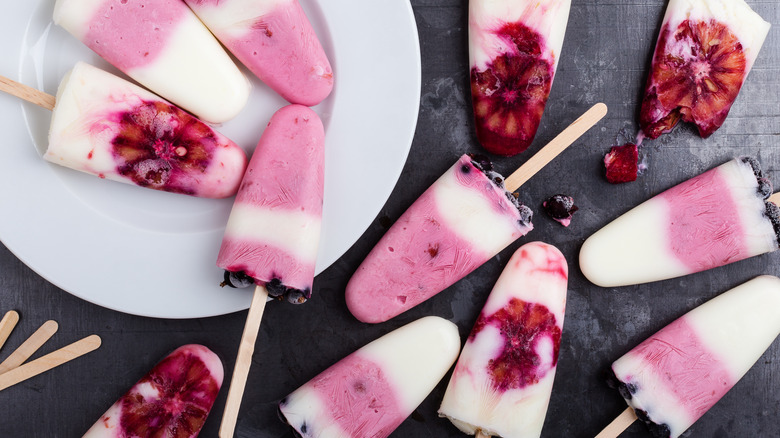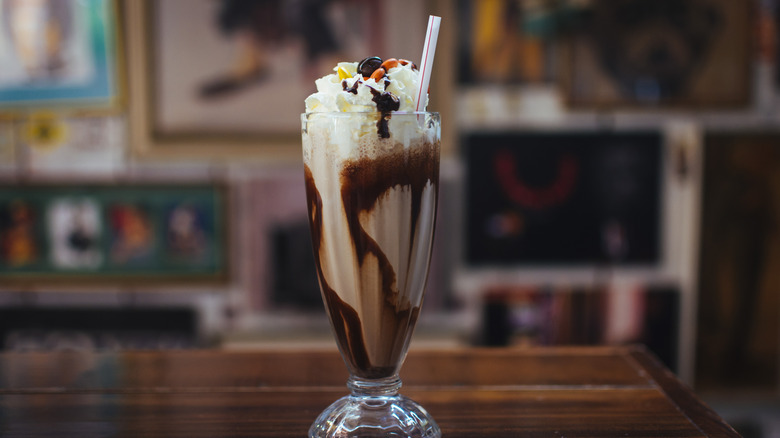Frozen Yogurt Vs Custard: What's The Difference?
A creamy frozen dessert can be a treat no matter the weather, but do you actually know what kind you're enjoying? We tend to lump things like custard and frozen yogurt under the general category of "ice cream," but in truth, there is much to learn about what sets them apart. Not only will this help you choose the best option for your dietary preference, it will also help you identify which style your taste buds actually enjoy most. To sort out these differences, we spoke with Katherine Sprung, pastry chef and founder of Squish Marshmallows, in an exclusive Food Republic interview.
So, frozen yogurt versus custard, what's the difference? As Sprung shared, "Frozen yogurt and custard are both delicious, but they're going to be different in taste and texture." While you may think of the texture of these desserts as being universal, the difference in ingredients leads to some being thicker, while others have a slightly more icy consistency. Of course, this means that each dessert takes on flavors differently, hence why you tend to find more flavor variety with frozen yogurt — it's slightly less sweet and creamy. Small changes in ingredients make a big difference in serving method, the best topping pairings, and the general enjoyment of these treats.
What is frozen yogurt?
As the name implies, frozen yogurt is made of that primary ingredient alongside just a few other necessary mix-ins. As Katherine Sprung described, "Frozen yogurt doesn't include eggs, and is just the yogurt, sometimes with the addition of milk." As a result, not only is this dessert less thick, "but it's going to have a lower fat content, if any, and have a less sweet and tangier flavor," according to the expert. This is also great to note for those who have egg allergies, but still want to enjoy a creamy dessert. If you've ever visited a fro-yo establishment, you may have noticed that the product has a brighter, more tart flavor profile compared to the sweetness found in custard. This is because yogurt is made from heated milk blended with food-safe bacteria.
The fun thing about frozen yogurt is that it's incredibly easy to make at home. You can use prepackaged yogurt to make a one-ingredient ice pop, or head to the store and buy your favorite yogurt flavor to add to a mold and freeze. Also, because of its tangy flavor, frozen yogurt pairs really well with fresh fruits. Add chopped blackberries to your yogurt mixture before freezing to bring out the treat's sour elements, or top a bowl of fro-yo with summer fruits like mango or peaches for a bite of sweetness. You can also add other classic frozen yogurt toppings, like brownie chunks or M&Ms — it all comes down to a matter of preference.
What is custard?
To avoid confusion, it's important to keep in mind that there are three common types of custard that have their own distinctions – but we're here to talk about the frozen kind. The main thing that separates frozen custard from frozen yogurt is the addition of eggs. According to chef Katherine Sprung, "Custard uses egg yolks, milk, and cream, which are higher fat ingredients ... [that] give it a creamier and richer mouth feel (the color will also be more yellowish)." It's hard to miss how decadent custard can be, as it doesn't quite melt or turn icy in your mouth the way fro-yo does; and this texture is definitely part of the appeal. The higher fat ingredients are also what separate custard from ice cream.
There are plenty of ways to enjoy frozen custard, such as a classic scoop in a waffle cone with rainbow sprinkles just like you'd see in a cartoon. The unique texture, especially when freshly churned, also makes custard a better option for certain serving methods like milkshakes. With custard mixed in, you can enjoy its rich and creamy texture provided by the eggs, all without worrying about your frozen dessert becoming watery or melting too quickly. Custard's naturally sweet flavor also lends well to complementary toppings that blend in with the sugary flavor. This could mean creating classic combos like cookies and cream, or adding chunky syrups like peanut butter. The truth is, there is no right or wrong way to enjoy both custard and frozen yogurt, so long as you know which is which.



